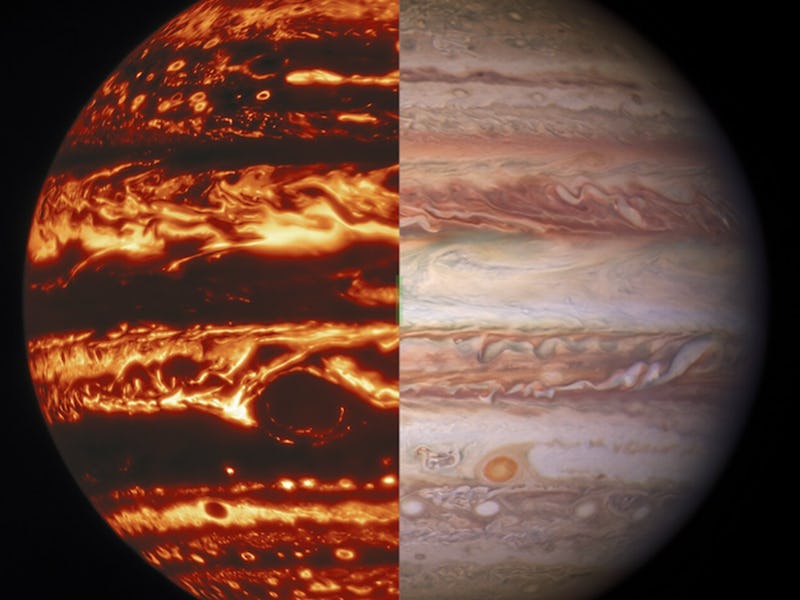Jupiter’s Great Red Spot extends deeper beneath Jupiter's clouds than we ever thought
The Great Red Spot is causing fluctuations in the planet's gravitational field.

The atmosphere of Jupiter is quite well known for its violent storms, the largest of which has been raging on in a counterclockwise swirl for more than 100 years: the Great Red Spot.
The legendary storm is so wide that it could swallow up Earth itself.
And now, astronomers have discovered that the storm also goes deep — much deeper than they previously believed. Based on data from the Juno mission, scientists found that Jupiter’s storms go well beneath its clouds, and get a good look at the inner workings of its clouds.
The new discovery is detailed in several papers published Thursday in the journal Science and the Journal of Geophysical Research: Planets, as well as the Geophysical Research Letters.
The Great Red Spot is a high-pressure, anticyclonic storm, and the largest in the entire Solar System. The storm causes its clouds to spin counterclockwise at a speed of more than 400 miles per hour. In comparison, a category four hurricane on Earth has winds reaching up to only 150 mph.
Our entire planet could fit into Jupiter’s largest storm.
But that’s not the only storm that occupies Jupiter’s atmosphere. In fact, the planet is pretty much covered in storms.
Storms tend to be long-lasting on the gas giant planet because it has no land, and its weather is mainly fueled by the planet’s internal heat.
But scientists have always believed that Jupiter’s storms go only as deep as sunlight can penetrate the planet, and where water still condenses. However, the new study showed otherwise.
WHAT’S NEW — Using data from NASA’s Juno mission, the scientists behind the new study looked at the vertical structure of the Great Red Spot, along with two other storms on Jupiter.
Since it entered Jupiter’s orbit in July 2016, Juno has orbited Jupiter once every 53 days. The spacecraft uses a suite of onboard instruments to peer beneath Jupiter’s cloud tops.
Juno’s microwave radiometer can see up to hundreds of miles deep into the planet, and it showed that the storms extend below the level at which water condenses and clouds form.
Some of the storms extended 60 miles below the cloud tops while other storms, including the Great Red Spot, extended over 200 miles.
But although the Great Red Spot goes deep into the planet’s atmosphere, the surrounding jets that power the storm go even deeper. While the Great Red Spot extends to around 500 kilometers into Jupiter’s atmosphere, the surrounding jets go further down to depths almost 3,000 kilometers deep.
On Earth, water and sunlight play a major role in the formation of storms. But on Jupiter, that does not seem to be the case.
“These roots go down deeper and pass right through the water cloud like it doesn't even matter,” Scott Bolton, principal investigator of Juno from the Southwest Research Institute in San Antonio and lead author of the Science paper, said during a press conference. “And so how that works is gonna require new models and new ideas to explain.”
This shows that there may be a connection between Jupiter’s interior and deep atmosphere.
Another Juno view of the Great Red Spot.
WHY IT MATTERS — Jupiter is the largest planet of the Solar System. It is so large that all the other planets could fit inside it.
Scientists study Jupiter closely since it could hold the answers to the origin story behind the Solar System.
“This size is one of the key reasons that it's really of high interest to us because it's so large and massive that it's thought to have formed first,” Bolton said. “So when we study Jupiter, we're taking a look at the very early part of the Solar System, how did planets form? Where did we come from? How is our Solar System made in general?”
WHAT’S NEXT — The Juno mission was meant to wrap up its mission by plunging into Jupiter’s atmosphere on July 30, 2021.
But NASA decided to breathe new life into its hefty spacecraft, extending the mission until September 2025. The mission’s extension will include 42 additional orbits, in which the spacecraft will conduct close flybys of Jupiter’s north polar cyclones, Jupiter’s moons Ganymede, Europa, and Io, and the first exploration of the faint rings that circle the planet.
Abstract — Jupiter’s Great Red Spot (GRS) is the largest atmospheric vortex in the Solar System and has been observed for at least two centuries. It has been unclear how deep the vortex extends beneath its visible cloud tops. We examine the gravity signature of the GRS using data from twelve encounters of the Juno spacecraft with the planet, including two direct overflights of the vortex. We identify localized density anomalies due to the presence of the GRS, which cause a shift in the spacecraft line-of-sight velocity. Using two different approaches to infer the GRS depth, which yield consistent results, we find that the GRS is contained within the upper 500 km of Jupiter’s atmosphere.